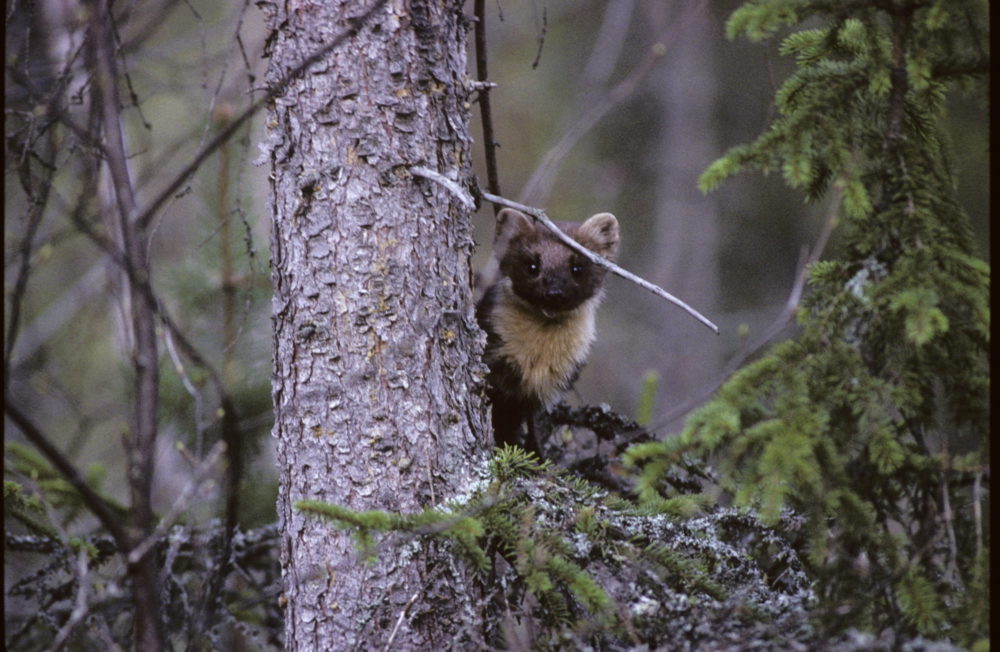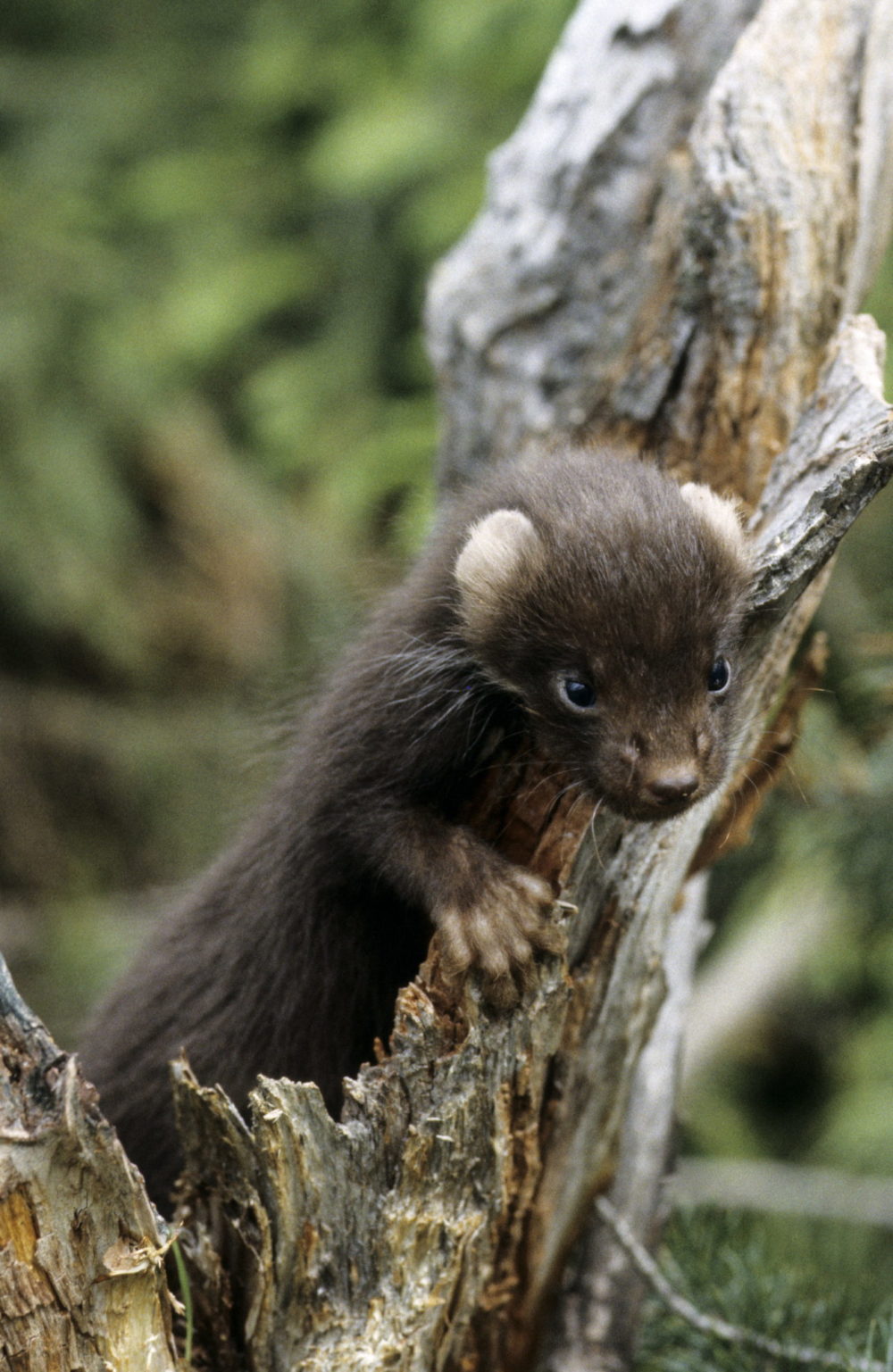Pine marten
Written by Nicklas Iversen | Last edited 10. June 2021
The pine marten is an interesting mustelid that spends as much time in trees as it does on the ground. Get to know this amazing climber better!
THE PINE MARTEN'S PHYSIQUE
The pine marten has a slim, elongated body with a long, bushy tail. The body is covered with chestnut or dark brown fur with a characteristic creamy yellow ‘bib’, which runs down to the front feet.
It’s summer and winter coats are roughly the same colour, but it’s winter coat is much glossier than it’s summer coat.
The pine marten has several adaptations that make it good at climbing trees. It’s long tail gives it better balance when jumping from tree to tree, while its sharp claws help it to climb up tree trunks quickly.
The pine marten has a total body length of 40 – 55 centimetres, while it’s tail is 20 – 30 centimetres long. It usually weighs 1 – 2 kg, and the male is typically slightly bigger and heavier than the female.
WHAT DO PINE MARTENS EAT?
Pine martens eat any small rodents and other small animals they can find, and are anything but picky. In spring and summer, they are more than happy to eat bird eggs and young birds, which are easy prey for these tree climbers. They also eat whatever they can get hold of in the way of small rodents, insects, snails and frogs.
Towards late summer and autumn, the pine marten is an expert when it comes to robbing bumblebee and wasp nests to steal honey. When autumn arrives with a vengeance, they like to eat berries, mushrooms and nuts, but still take any small animals they can get hold of.
In the winter months, they mainly hunt squirrels and small rodents. The pine marten is especially well known for hunting squirrels, typically seeking out animals that are sleeping or resting at night. If there are not many of these rodents available, it can also dig through the snow to eat frozen lingonberries!
If a pine marten happens across a carcass, it will rarely say no, and finding the remains of a roe deer left by a lynx is a real feast.
Foto: Ernst Granneman PhotoGrany med CC BY-SA 4.0-lisens.
HOW DO PINE MARTENS LIVE?
The pine marten lives in dense forest, preferring old coniferous or mixed woodland. It spends around half it’s time on the ground and the rest up in the trees. Nor is the pine marten averse to going for a quick swim, but will not hunt in the water.
Like many other mustelids, the pine marten is a very antisocial species. It claims a territory, which it will mark with gland secretions, faeces and urine, and defend it against other pine martens of the same sex if necessary. The males have larger territories than the females, and the female’s may well overlap slightly with that of the male.
The pine marten will have a kind of den in it’s territory, but males and young females without cubs prefer just to use something simple like an old squirrel’s nest (drey) or crow’s nest to sleep in.
In winter, the males can tolerate having young animals living in or partly in their territory, but will drive them off when spring comes and the breeding season starts. The males will then gradually become more aggressive towards other males and chase possible competitors away.
The pine marten spends most of it’s time in deep woodland or scrub, but may also make quick trips up into rocky areas or open countryside from time to time. There may be good opportunities to get a fairly easy meal in such places, but at the same time it will be easy prey for large birds of prey, so such expeditions are not without risk.

PINE MARTEN'S REPRODUCTION
The female pine marten becomes sexually mature in her second year, after which she will probably have a litter every year. The breeding season lasts from June to August and so is much later in the year than for most other mustelids.
In spite of the late breeding season, the young are not born until the next spring. This is due to what is called delayed implantation, with the egg not being implanted in the uterus for a time. In the case of the pine marten, it can be nearly three quarters of a year before the egg is implanted! Once it is implanted, the pine marten will be pregnant for a month before giving birth to between one and eight young, though two or three are most usual.
The young are born in a den, and this natal den will be a bit more extensive than the resting sites for males and young animals. The female pine marten typically uses a hollow tree, such as an old pine, as a natal den.
The pine marten cubs are tiny, deaf and blind when born, and weigh no more than 30 grams. It is five or six weeks before they are ready to explore the area outside the den, and another couple of weeks before they are strong enough to explore much beyond the closest trees.
At around two months old, they are ready to accompany their mother on hunting expeditions, and from then on things move quickly. In about August, they leave the mother despite not being fully grown until November.

WHERE ARE PINE MARTENS FOUND IN NORWAY AND AROUND THE WORLD?
In Norway, we have pine martens pretty much all over the country, even in Finnmark in the far north. They are much commoner south of Trondheim, however, and their distribution is closely linked to dense forest.
The pine marten is also found in much of Europe, right down as far as Northern Spain and Italy, and eastwards towards North and Central Asia. All these areas also have other types of marten, such as the beech marten (Martes foina). The beech marten looks very like our pine marten, but it’s bib is white instead of creamy yellow.
Foto: Rogersnäll med CC BY-SA 4.0-lisens.
CHALLANGES FACING PINE MARTENS
Challenges facing pine martens
Although the pine marten can be killed by other predators and birds of prey when it is in an open landscape, such losses are not significant in terms of the national population. Humans, on the other hand, are the pine marten’s greatest enemy, and hunting is permitted.
In a way, red foxes are also a challenge for the pine marten, as they like to share the same food sources. It has, in fact, been shown that the pine marten population increases rapidly if the red fox population is reduced in an area, so the fox probably helps to keep the population under control. So if more foxes enter an area, it may mean that the pine martens will have greater difficulty finding enough food and sometimes starve to death.

LEARN MORE ABOUT THE PINE MARTEN
You can learn more about the pine marten on the following websites:
- Pine marten at the Norwegian Biodiversity Information Centre.
- Pine marten at Store norske leksikon.
- Pine marten at the Norwegian Institute of Public Health (FHI).
We have also used them as sources for this information page on the pine marten.
This article has been written by Nicklas Iversen, a former nature guide for Visitor Centre Carnivore Flå.